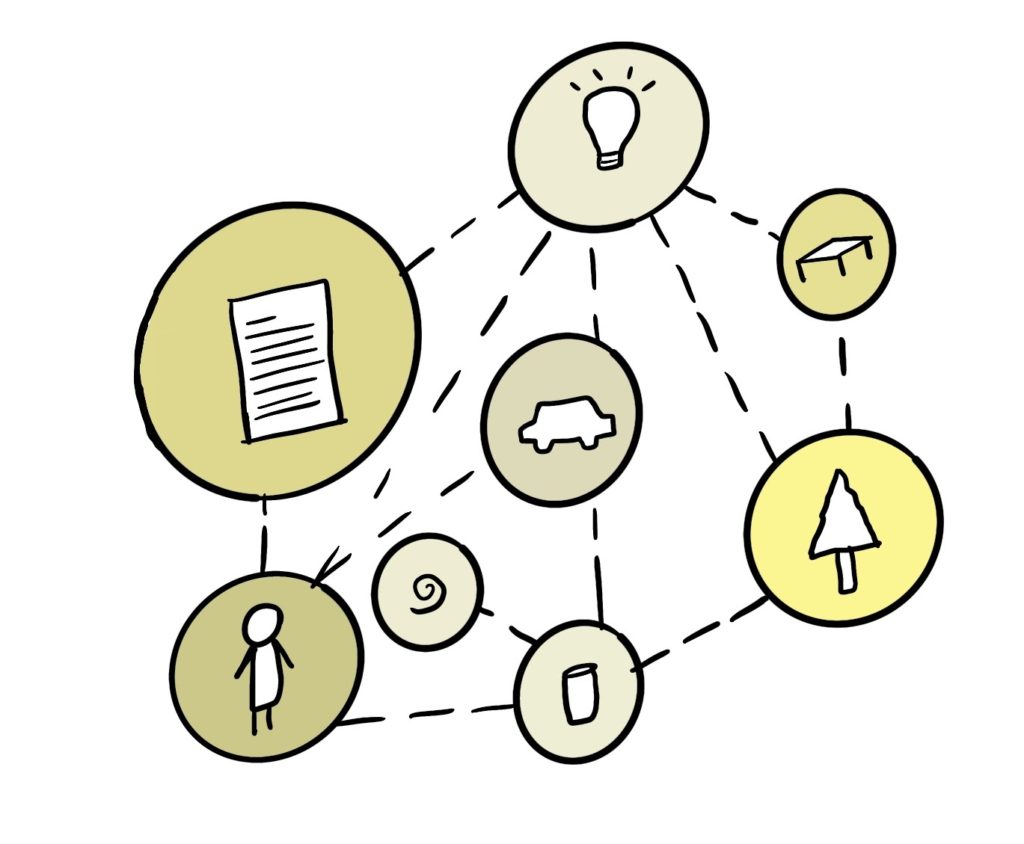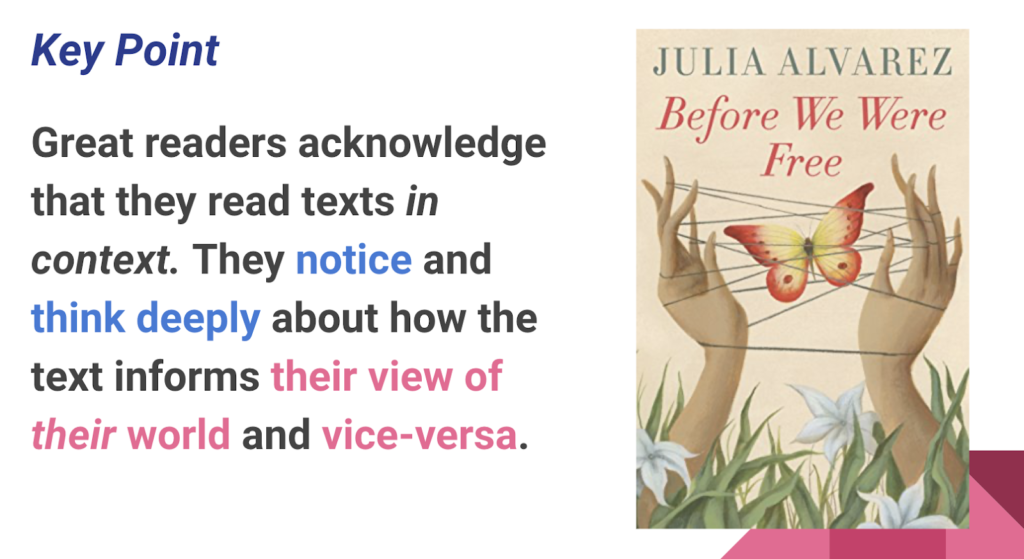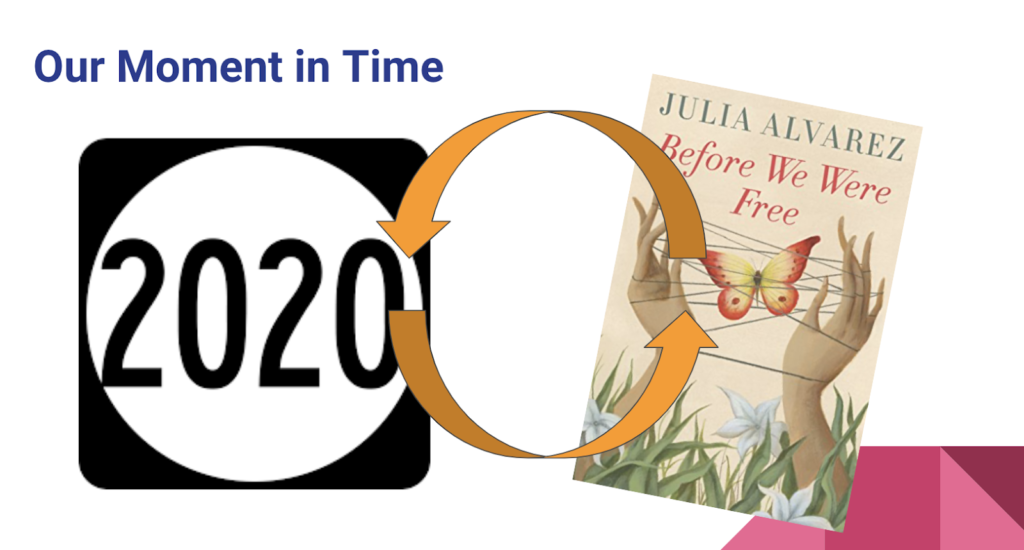With Danielle Perkins
***
Before jumping in, we must confess: we are not fans of e-school.
In fact, we love real school. Brick-and-mortar school. And we are skeptical that remote learning will ever rival the real thing. We miss the casual buzz of hallway catch-ups; the shared air of discussion circles; even the cluttered corners of well-used classrooms.
Despite our love for real school, we have spent the past month online, co-teaching a middle school literature unit for a national remote summer school. And, though we still ache for shared air and cluttered corners, we must admit that we are having a pretty phenomenal experience. Make no mistake: we’re still real-school people, through and through. But we have come to believe that online instruction can be rich and rewarding, both for students and for teachers.
We write this piece to share some of the practices and approaches that are working for us as freshly-minted online educators. We think it’s important, now more than ever, that teachers share best practices for positive, productive remote learning. The debate over reopening schools is raging: the trend, it seems, is to rush back to campus, at great risk to children and educators. The argument: we need to get kids back into school buildings; remote learning has been a total failure. While real classrooms may be the preferred option – certainly, they are ours – we do need to challenge the idea that they are the only option, especially when lives are at risk.
We simply can’t afford to downplay safety and health concerns – to run away from remote learning – just because this spring was rocky. As a profession, we are still brand new to e-school en masse. The more we develop and share best practices, the more we can transform e-teaching into a viable, enjoyable, and effective option. Like it or not, in a pandemic age, remote instruction is an option we need.
In that vein, here are our six tips for teaching literature online:
Tip 1: Choose the right text for right now.
Selecting a relevant and engaging text is always critical when constructing a literature unit. But we think that teaching online – and teaching online in 2020 – amplifies the importance of strong text selection.

Remote learning is a special kind of taxing: the screen time, the tech issues, the distractions. The texts we select have to be “worth” all this taxation. Students have to see and feel that this book, at this moment, is worth their time and energy.
We believe that, at this moment, our time and energy can (and should) most readily acknowledge texts that speak to our country’s surging movements for racial and economic justice. Our minds and hearts grapple to understand the persistence of systemic inequity; they ache to find and enact liberatory paths forward. As educators, we should choose novels that deepen, challenge, and inspire such grappling and aching.
We agonized over text selection for this summer, and we’re glad that we did. Ultimately, we landed on Julia Alvarez’s Before We Were Free. Set in the Dominican Republic in 1961, this stunning novel tells the story of Anita Del Torre, a thirteen-year-old girl whose family is leading the resistance effort against Rafael Trujillo’s brutal dictatorship. Throughout, Anita grapples to understand the meaning of freedom; the costs of political oppression; and the sacrifices required in fights for liberation. It is a text richly resonant with our own moment in time. Our students drew immediate connections between Anita’s freedom fight and the battles for liberation in the U.S. today. They appreciate reading a book that supports deep, nuanced thinking about the big ideas already on their minds.
Tip 2: Intentionally invite connection.

In addition to selecting a relevant text, we specifically named for students that one of our course objectives is to draw connections between the novel and current events.To some, this might sound obvious; but too many common-core era ELA programs reject reader-response style thinking, falsely suggesting that such thinking is non-intellectual or at odds with formal analysis. In our course, we plan to have it all: to trace themes, to analyze motifs, to parse diction; and to reflect on our own contextualized responses, to name our connections, our feelings, and our ideas.
When we began our novel unit, we told students that we specifically chose this text because we found it resonant with the events of 2020. We also constructed a specific “teaching objective” to show students how much we valued their personal connections:

Along with naming a “connection” objective, we have created consistent, recurring spaces to discuss the novel and current events together.In our first week of class, for example, we dedicated an entire seminar to these three questions:
- What are you noticing about what’s happening in the world?
- How are you feeling about / experiencing it?
- What might this mean for us as we read a novel about freedom?
In other lessons, we use the image below to cue similar conversations, inviting students to share the connections they are forming between the novel and their experience of our world today:

Tip 3: Don’t rush.

In selecting our novel, we are glad that we paid serious attention to text length. With only five weeks to teach our unit, we knew that it would be challenging to read a long book. This concern might seem logistical, but it is, in fact, pedagogical. When rushed, teachers enter a world of forced choice: to keep pace, we need to cut minutes somewhere: community building, norm setting, historical context, discussion, writing, projects, paired texts. Sadly, such forced choices often discourage depth, flexibility, and responsiveness. The unprompted question and the runaway discussion become threats to the pacing calendar – when they should be joyful moments of insight and learning.
Teaching online only exacerbates time pressure. No matter how facile we become as remote educators, screen time, connectivity issues, and google-doc-toggling are destined to eat our instructional minutes. It’s best to remain realistic and conservative in time estimates.
At 163 pages, Before We Were Free was a great selection for a five-week unit. In fact, we can comfortably read the text within four weeks. We dedicate the last week to synthetic seminars and project work.
So, match your text to your unit length; or adjust your unit length for your text. But avoid rushing at all costs!
Tip 4: Take time to build community.

Another huge – and necessary – benefit to a generously paced unit is that we have been able to take the time we need to build our classroom community.
We would never “skip” the step of building community in our 3D classrooms. Though we knew that 2D space would strain our tried-and-true team-building tactics, we were staunchly committed to cultivating a happy, healthy classroom culture.
We did not launch into content on day one. Instead, we opened by sharing our responses to a simple, two-part question: What is a fun fact about yourself as a person? What is a fun fact about yourself as a reader? The simplicity worked for Zoom, and we forged surprisingly fun, deep connections as we talked. We discovered, for example, a class-wide love of mythology; Mr. Malone was chastised for never having read the Percy Jackson series (he’s sorry!).
As the summer has progressed, we’ve continued to discuss simple, daily, team-building questions. We open each class with five minute “would you rather” or “what’s your favorite” inquiries. These questions have sparked really fun and authentic conversations about everything – from roller coaster preferences to current events.
Of course, discussing great, relevant literature remains the thrust of our community building – but Zoom has not deterred us from taking small moments, every day, to bond “off script.” And we are grateful that our unit pacing allows us to grow our community without bemoaning the loss of instructional time.
Tip 5: Assess student thinking in meaningful but workable ways.

When our program recommended that we use a multiple choice quiz to assess student learning in our course, we said: No.
We don’t happen to love multiple choice in any literature unit; but assessment philosophy is not our present focus. We do, however, want to underscore that online instruction is particularly inhospitable to traditional pencil-and-paper assessment modes.
Here’s the good news: online instruction is particularly hospitable for assessing student thinking in other, better ways – specifically, by analyzing students’ formal and informal writing. Google classroom is one platform that makes it fairly easy to collect and scan student responses. On a daily basis, without stacks of papers in wire trays, we gather, read, and respond to students’ work samples. It’s never been easier to give students feedback, nor to reflect on what student work is revealing about our own teaching practice.
For a summative assessment, we again rejected traditional testing. Instead, we designed a cumulativeprojectthat asks students to creatively synthesize their learnings from the novel and to apply them to their current contexts. In Before We Were Free, Alvarez writes of testimonio, a Latin-American tradition holding that “the responsibility of those who survived the struggle for freedom [is] to give testimony” (166). To close out our course, we ask students to construct their own testimonio, reflecting on their witnessing of and participation in present-day fights for freedom. Students can select any genre/media for their testimony: fiction, poetry, visual art, video, etc. Every week, we dedicate one seminar to students developing their testimony, beginning with brainstorming and moving on to revising, finalizing, and sharing.
Yes, there are some fancy software programs that can push multiple choice and short response questions to student screens; and big-brother style “guardian” softwares that allow teachers to monitor “testing integrity.” But does this really make sense for online assessment? We argue that such assessment modes are impractical for online learning – and, if we’re being honest, pedagogically stale (if not injurious). Remote learning is a great opportunity to set aside traditional testing, and to design workable, meaningful assessments instead.
Tip 6: Elevate discourse!
We challenge the notion that remote learning cannot feature rich discussion, though we acknowledge that teachers and students will need to evolve their discussion routines for online spaces. Here’s how we have lived out our commitment to discourse-rich pedagogy this summer:

- In a typical read aloud lesson, we stop about 3-4 times per chapter for short discussions. At these moments, we pose interpretive questions. We invite students to participate “on the mic” or “in the chat.” That is, students can come off mute and share their thoughts out loud; or they can type their ideas into the Zoom chat. If students surface particularly valuable thoughts in the chat, one of us will read them out loud, crediting the writer. This sounds like: I see in the chat that Briana thinks the diary might be a symbol of Anita’s self-reliance. What do others think? By not placing value on a specific mode of participation (i.e., you have to speak out loud, or you everyone needs to use the chat), we have created an environment where students can navigate online spaces in ways that feel comfortable for them.
- At the end of the chapter, we host a longer discussion. In addition to the participation modes described above, we have found this to be a great opportunity to “chat” developing ideas on a google document that is shared on the meeting screen. For example, we might pull two or three contrasting interpretations from the chat, put them on to the google document, and ask students to discuss what they notice about the interpretations and which they believe to be most valid. Or, we might type out a particularly evocative idea, and ask students to provide evidence for/against this idea, typing their contributions as they speak/type. We have also selected drafts of students’ written responses and revised them together, live, tracking changes as we go.
- Here’s an example: as students analyzed this poem by Alvarez (one of our paired texts), we pulled samples of their literal and “deeper” interpretations of the poem and displayed them on the screen. Then, we asked students to celebrate, critique, and build off of one another’s developing ideas.

We’re still experimenting with all the ways that we can enhance discourse and visible thinking in our class. But, we have definitely rejected the idea that online learning cannot foreground dialogue – and our course is the better for it!
Bonus Tip: Co-teach, if you can!
Co-teaching has been a source of great efficacy and joy for our online course. In preparing lessons, we have benefited immensely from sharing ideas with one another – and while this would be true in 3D school, it has been especially true for remote school. We are both adjusting to this new kind of instruction. Working together, we have been able to generate and pressure test ideas about adapting our instructional practices for the internet.
It has also been invaluable to enact online lessons with a co-teacher. When one of us is reading or leading discussion, the other is able to manage the Zoom chat feature. Here, we can respond to, validate, and probe students’ chat comments; we can also model and prompt thinking without interrupting the live dialogue (i.e., “What do you make of Laniya’s idea?” or “Is anyone else drawn to the imagery in paragraph 8? What might it represent?”). In a more practical (but very real) vein, co-teaching enables us to support student tech issues as they arise.
So, if your school can support co-teaching, we highly recommend it. Online teaching is bound to have its highs and lows; and as the proverb goes: “shared joy is double joy; shared sorrow is half sorrow!”
***
We don’t think we’ll ever love teaching online as much as we love teaching in person. But our world is changing. In response, we need our global community of practice to share what’s working. We need to evolve online learning, such that teachers and students can continue to love class, even when – to stay safe – class is mediated by screens. In that spirit, we hope you found these tips helpful – and that you will share your own!
Danielle Perkins and Andy Malone are mentor teachers with the National Summer School Institute. During the year, Danielle teaches 8th grade literature and Andy designs secondary school programs.
Graphics by Maru Perez Benavides; Instagram @maru.arq.



